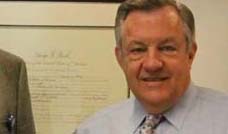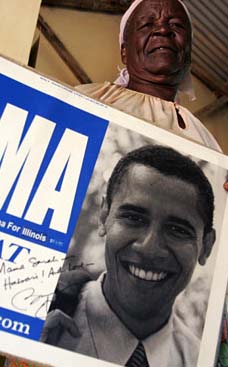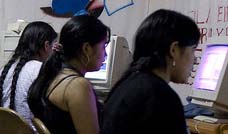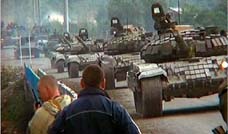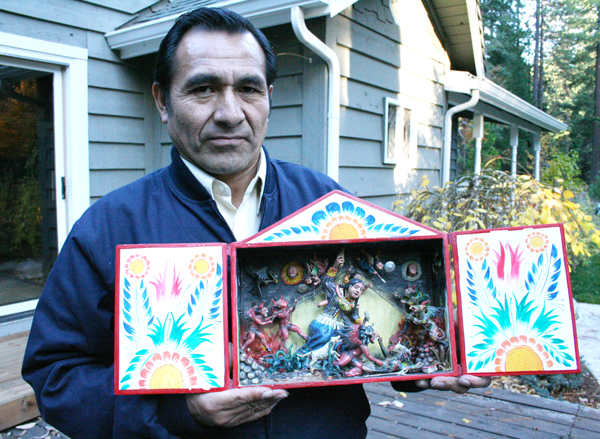
"Retablos, a traditional Latin American art form, are intricate three-dimensional altarpiece shadowboxes made of wood, a flour and glue plaster mix, and tempera paint. In Peru, retablos are also made using potatoes. Jimenez is one of a generations-long family tradition of retablos makers, having begun his apprenticeship at the age of 9 by helping his grandfather repairing religious altarpieces in their village’s churches. The art of retablos dates back hundreds of years and encompasses two main styles: the costumbristats which depict traditional festivals and everyday activities, and testimonials which depict movements of social and political change. Jimenez also crafts similarly decorated crosses and mirrors." Tony D'Souza, author of "Whiteman," served three years in a village in Ivory Coast, where he worked as a Peace Corps volunteer, teaching villagers how to prevent HIV/AIDS.
Tony D'Souza writes: Peruvian artist offers COS workshops
Peruvian artist offers COS workshops
Caption: Peruvian retablo artist Claudio Jimenez Quispe displays one of his works, “La Campesina” (The Countrywoman). Jimenez’s work often deals with the horrors of the civil war in his country between the Shining Path and the Peruvian government. The retablos are made of wood, plaster, and tempera paint.
By Tony D'Souza
Mount Shasta Area Newspapers
Wed Nov 19, 2008, 04:10 PM PST
Weed, Calif. -
Peruvian Retablos master Claudio Jimenez Quispe arrived in Siskiyou County this past weekend to begin a week-long visit to College of the Siskiyous. Sunday evening found him at the north Mount Shasta home of his long-time friend Barry Russell, Vice President of Instruction at the college. In the fading evening light on Russell’s tree-shaded property in the shadow of Black Butte, the soft-spoken and humble Jimenez described in Spanish his work, life, and the culture he works to record through his impressive artistic oeuvre. The wind picked up for a moment as he spoke and Jimenez slipped his hands into the pockets of his coat against the cold.
“It’s cold in the mountains of Peru,” Jimenez smiled and said. “But we don’t have the wind like here. This is my first visit to the Siskiyous. This area is incredibly beautiful with gigantic trees, but the wind makes it chilly.”
“Claudio lives in Lima,” Russell explained for his friend. “The climate is similar to Los Angeles and he’s gotten used to that.”
Though he calls Peru’s capital home these days, Jimenez hails from a rugged, and poor, mountain region in Peru called Ayacucho where the principal language spoken is the indigenous Quechua, the tongue of the Incas. Ayacucho was one of the areas in Peru most affected by the long and bloody civil war waged between the Shining Path guerrilla army and the Peruvian government. Little noticed by most Americans in a world of similar clashes, the war in Peru involved numerous issues, some which date to the conquest of the Incas by the Spanish conquistador Pizarro and the imposition of Catholicism over the native religions. Through the course of the war, the Shining Path became one of the most notorious rebel organizations in the world for the brutality of its tactics, extreme acts of terror and violence mirrored by the Peruvian government’s own atrocities.
“It was similar to what happened in Chile under Pinochet,” Russell explained. “The government rounded up young men of military age and labeled them as ‘terrorists.’ Then they killed them in the main soccer arena. The men just disappeared, and the women who were left behind couldn’t talk about it.”
In Chile, Russell continued, the women created an art form called arpilleras (a style of tapestry). Though they couldn’t speak overtly about what had happened to their husbands and sons for fear of government reprisal, they managed to stitch their loved ones’ stories into the scenes in their colorful arpilleras. This allowed them to smuggle messages past unsuspecting guards to political prisoners in Pinochet’s jails.
In some ways, Jimenez’s retablos serve much the same function of documenting oppression and terror by violent men with guns. But unlike the hidden messages of the arpilleras, the retablos are overt in their ideas, the artist’s intent and feeling on riotous display once the retablo’s doors are opened.
Retablos, a traditional Latin American art form, are intricate three-dimensional altarpiece shadowboxes made of wood, a flour and glue plaster mix, and tempera paint. In Peru, retablos are also made using potatoes. Jimenez is one of a generations-long family tradition of retablos makers, having begun his apprenticeship at the age of 9 by helping his grandfather repairing religious altarpieces in their village’s churches. The art of retablos dates back hundreds of years and encompasses two main styles: the costumbristats which depict traditional festivals and everyday activities, and testimonials which depict movements of social and political change. Jimenez also crafts similarly decorated crosses and mirrors.
“What is most important to me now are making the testimonials,” Jimenez explained Sunday. “With the testimonials, I hope to record the culture of Peru, to create a work of art that is an expression of ‘social anthropology.’ I hope to include the literature, the history, the clothing. In this, you can say everything. Testimonials allow the artist the opportunity to speak about his own life, his own experience. My inspiration comes from a desire to document what happened. Sometimes I spend six or seven months researching a subject before I am ready to begin the work.”
What is most clear is that Jimenez allows his retablos to tell his personal story indirectly. Imprisoned and tortured by the Shining Path for his unwillingness to join the movement and for his outspoken art, today, according to Russell, Jimenez finds himself reluctant to speak openly about how he suffered during the war. Russell attributes this to Jimenez’s traditional code – common among the people of the Andes – of not speaking negatively about anything. As both Russell and Jimenez explained, the people of the Andes share three common life principals: “Do not be a liar. Do not be a thief. Do not be lazy.”
But Jimenez does not need to talk himself about the past in Peru, because his retablos tell the whole of the story, and more. Jimenez’s retablos are at once startling and disturbing works for their frankness about the horrors of the war and the difficult choices the war forced innocent people to make. Jimenez and Russell opened the doors of a retablo titled “The Country Woman” on Russell’s patio Sunday evening, a sanguine example of what happened in many Peruvian villages in the war. In the retablo, a country woman struggles with all of her might to wrest her children from the hands of demons. The demons represent the Shining Path and the Peruvian Armed Forces. Both factions in the war were known for stealing children to feed the engines of their war.
Russell first met Jimenez roughly 10 years ago on a trip to Peru through a mutual acquaintance, and the pair became instant friends. In the ensuing years, he has hosted Jimenez and his work at the various academic institutions he has served at. In bringing Jimenez to COS, Russell again hopes to expose students to a difficult story of survival and bravery that they wouldn’t otherwise hear, as well as to an art form they may not otherwise encounter.
“It’s the beauty of the work as well as the impact of the stories,” Russell explained of his admiration for Jimenez’s work. “[His work] is so rich in cultural stories; they also talk about social problems, about drinking, tobacco, cocaine. Some of it is light-hearted. Some is very religious. He has a very religious nativity scene. He has a retablo of a retablo maker making a retablo.”
Jimenez’s retablos have found home in the permanent collections of some of the most prestigious art museums in the world. But there is no hint of vanity or ambition in the man. Asked how long some of his larger pieces take to complete, Jimenez simply said, “Years and years.” Asked if any of his four children will follow his artistic path, Jimenez released a smile and said, “All of them.”
For more information about Claudio Jimenez Quispe’s visit to the College of the Siskiyous, contact the college at 938-5201, or his host Barry Russell at 938-5201.








